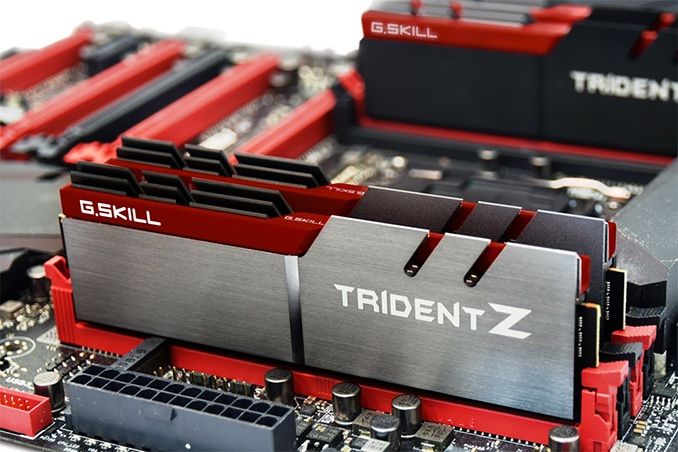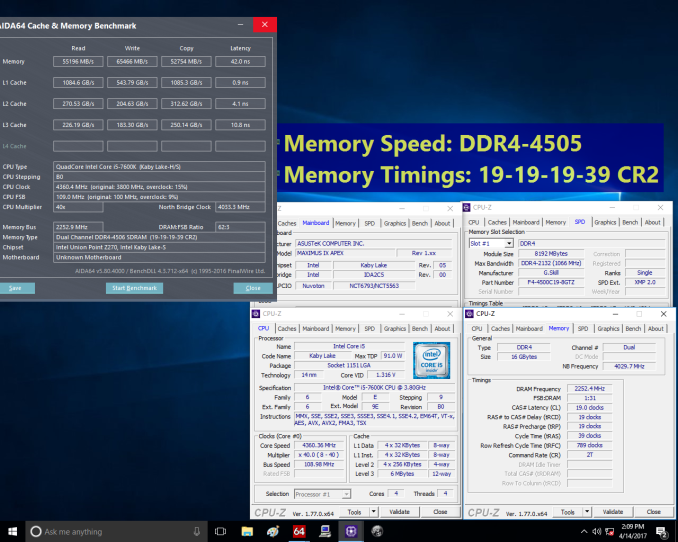G.Skill Announces 16 GB DDR4-4333 Memory Kit for Intel Kaby Lake CPUs
by Anton Shilov on April 15, 2017 1:00 PM EST
G.Skill on Friday announced its new top-of-the-range DDR4 memory kit for dual-channel PCs running Intel’s Kaby Lake processors. The new Trident Z kit for operates at 4333 MT/s (DDR4-4333), though it requires a bit of extra voltage to get there. In addition, the company said that it was working on even faster DDR4 DIMMs.
The new G.Skill Trident Z memory modules are based on Samsung’s 8 Gb DRAM ICs (B-die, 20 nm), which also power other high-end DIMMs from the company. The 16 GB kit (F4-4333C19) consists of two 8 GB modules rated for DDR4-4333 operation with CL19 19-19-39 timings at 1.4 V, which is above the standard high-performance voltage setting for DDR4 (1.35 V) and is considerably higher than JEDEC-specification of 1.2 V. Just like the rest members of the Trident Z family, the new DDR4-4333 kit comes with aluminum heat spreaders (so, no RGB LEDs just yet) as well as SPDs with XMP 2.0 settings.
G.Skill is the Trident Z DDR4-4333 kit for use with Intel’s Z270 platforms and Kaby Lake processors. So far, G.Skill has only validated its F4-4333C19-8GTZ modules on the ASUS ROG Maximus IX Apex motherboard and the Intel Core i5-7600K processor, but expect the list of compatible mainboards to expand over time.
In addition to announcing the new DDR4-4333 kit, G.Skill also teased DDR4-4400 (F4-4400C19-8GTZ) and even DDR4-4500 (F4-4500C19-8GTZ) 8 GB memory modules working in dual-channel mode. The company is still working on such DIMMs and finalizing their specifications (timings, voltages, etc.), so do not expect them on the shelves for a bit.
It should be noted however that this week's announcement is just that: an announcement. The actual product release will come later. G.Skill has not yet announced when that will be; presumably the company is still binning chips and building up a launch supply. We'd also expect the retail price of the kit to be announced at that time. At present, a dual-channel 16 GB DDR4-4266 kit costs around $250, so it's reasonable to assume the new DDR4-4333 kit will be priced above that.
Related Reading:
Source: G.Skill
















23 Comments
View All Comments
BrokenCrayons - Monday, April 17, 2017 - link
That number isn't really that bad. As the memory's clock speed rises, the amount of time each cycle takes to complete decreases. More cycles may not actually mean higher latency. Though I do agree with the general idea of aggressively lowering latency in addition to raising memory speed, there are physical limits that are difficult to overcome.MrSpadge - Wednesday, April 19, 2017 - link
It's actually faster than DDR4-3200 14-14-14. There the latency is 1/3.2 * 14*2 = 8.75 ns, whereas for DDR4-4333 19-19-19 it's 1/4.333 * 19*2 = 7.03 ns.andychow - Tuesday, April 25, 2017 - link
The JEDEC standard is pretty much out of the window.